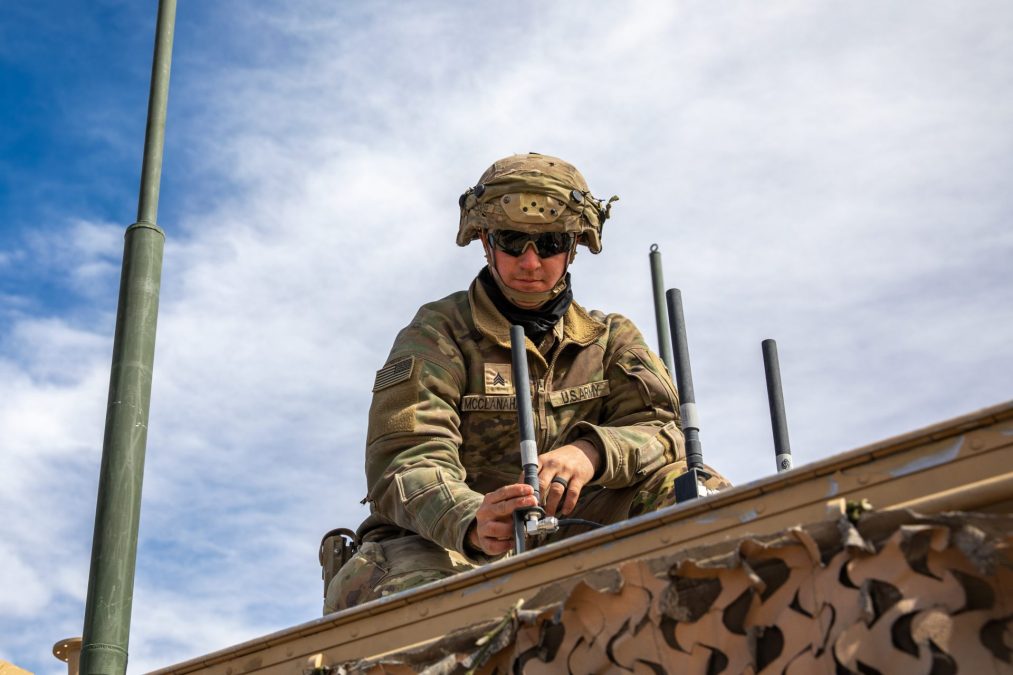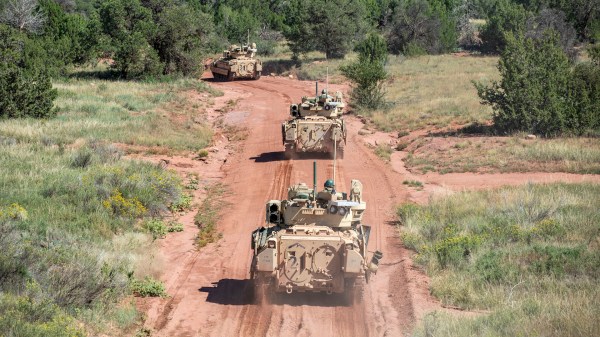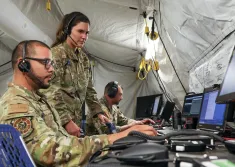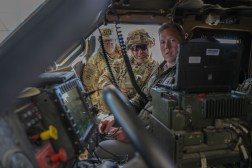Army using incremental ‘sprints’ to scale Next Gen C2 to division level

AUGUSTA, Ga. — The Army is gearing up for a set of incremental experimentation events, described as “sprints,” as it aims to scale its Next Generation Command and Control prototype to the division level next year.
NGC2, the Army’s number one modernization priority, is a clean slate to battlefield communications and data to provide commanders and units a new approach to manage information, data, and command and control with agile and software-based architectures. A prototype of the system was tested at Project Convergence Capstone 5 in March with an armored battalion and a higher headquarters element. Following that demonstration, the Army awarded an industry team lead by Anduril a nearly $100 million contract to continue the prototype — scaling it now to a full division, 4th Infantry Division, which includes all the enabling units.
In order to begin scaling to the full division for Project Convergence Capstone 6 next year, the Army will be undergoing a series of experimentation events that will incrementally add different capabilities. Those events will be based on warfighting functions rather than formations.
A major driver for the pursuit of NGC2 was that historically, warfighting functions were siloed with their own bespoke systems. For example, there was a system for artillery or intelligence or logistics that each individual staff section used, and none talked to each other. This created redundancy and interoperability concerns, ultimately undermining situational awareness on the battlefield for commanders.
In future conflicts, operations are expected to occur much faster, requiring data to be better synchronized and allow commanders to make quicker decisions.
The series of upcoming experiments will be called Ivy Sting, as 4th ID is nicknamed the Ivy division. Each Ivy Sting will add a new warfighting function, culminating in Ivy Mass, a full division event ahead of Project Convergence.
“One component will start Ivy Sting 1, deliver some more kit and capability in Ivy Sting 2, and so on and so forth, till you get to Ivy Sting Mass, which is a complete risk-reduction exercise that leads into PCC6,” Lt. Col. Richard Ricketts, deputy trail boss at program executive office for command, control, communications and networks, said in an interview at the TechNet Augusta conference last week. “We use those series of exercises with the division commanders to scale that brigades to support these Ivy Stings. Start small, grow big, identify what we need to do, and continue to iterate as we go forward.”
The trail boss concept emerged as the Army was developing modernized capabilities for priority units as a bridge to the “fight tonight” architecture while it was working on the longer-term NGC2 effort. The notion is to have a single person in charge of integrating across all PEOs given network equipment must work with platforms.
The goal for Ivy Sting is to allow the commander to see how the systems work in an operational context, rather than throwing the full stack of NGC2 solutions and all warfighting functions at a formation. For example, an Ivy Sting will be focused on testing the fires capabilities through a vignette allowing soldiers and the commander to see how they’ll prosecute targets using the new software.
These are typical events the division would be conducting anyway, but now, the division commander is trying to incorporate NGC2 capabilities on top to build it along the way.
The commander’s “intent was, ‘I’m going to take my plan training events, bring in the Next Gen C2 capabilities, I’m going to get the training benefit and the equipment assessment event’ … because part of what we need to see is how they’re going to use it. Not just did it do what it was supposed to do, but was it even the right thing?” Ward Roberts, acting deputy PEO at C3N, said in an interview. “Seeing the unit getting the training value out of the reps and sets with the equipment, us getting some feedback on the equipment — that should help us tailor as much as we can. The runway is running out to get to PCC6 so we can do now a little bit more, but the closer we get there’s going to be a little more refined.”
Maj. Gen. Patrick Ellis, commander of 4th ID, has unique insights into the NGC2 capabilities, having just previously served as the director of the C2 Cross Functional Team within Army Futures Command. In that role, he was charged with overseeing the prototyping effort of NGC2 at Project Convergence in March.
Now, as the operational commander, he is able to put the system into action and holds a distinct perch to help guide the continued prototyping in a way other commanders might not have.
“I think he has his own framework for how he wants to progress Next Gen C2,” Brig. Gen. Michael Kaloostian, C2 CFT director, said. He added that Ellis saw how modernized capabilities were added at other exercises and training events prior, providing him a roadmap of sorts for how to approach the efforts with his division.
Kaloostian descried Ivy Sting as a series of sprints, an approach used in the commercial software world.
“It’s just a sprint [cycle]. Constant sprint, until we get to where we want to be … Then we have Ivy Mass, which is that final big risk-reduction event, division-level exercise at Fort Carson, before they deploy equipment to [the National Training Center] for PCC6,” he said. “What Gen. Ellis wants to do is he’s going to have six of these exercises, about one every other month, and that provides about 45 days in between exercises where you can have that ‘all right, we just accomplished something, here’s what we want to accomplish in the next Ivy Sting. What are some of the things that we did not do well that we need to incorporate?’”
Inserting new capabilities
Alongside the prototyping effort with 4th ID, the program office is continuing to work with vendors for new capabilities in the future.
PEO C3N has released a commercial services offering as part of NGC2 where companies can continue to submit white papers based on capabilities.
Those could be just for small slices of NGC2, such as transport, or it could be the entire stack.
The intent is to be able to onboard new capabilities and vendors if they have a viable solution that works better than what currently exists. From the start of the effort, officials have noted that they want to flexibility to onboard and offboard contractors and capabilities, especially if companies are not performing. This is a significant departure from previous programming efforts where in some cases, the government was locked into a particular vendor for a period of time.
“The intent is, because it’s open, we can always use it as we have ideas, we have issues, vendors have good ideas. It could be as little as picking this one specific micro service and say ‘hey, let’s use this one and plugging it in.’ Or it could be holistically saying ‘you guys have been great, we’re going to shift to this new guy.’ It could be that full gambit,” Roberts said. “I think until we really hear back from industry and see what the options are, I don’t think we know yet.”
The Army also wants to keep its options open, which will also motivate industry to keep innovating.
“We want to see a different approach,” Kaloostian said. “We want to see a set of companies come in and provide a different approach than what the current sets [are] doing, because that’s going to drive competition and it’s going to provide us the ability to see what other companies, and just so we can better understand what other companies have to offer.”
That also applies to the prototyping effort. If, between now and Project Convergence 6, a company comes along with a better solution than one of the members on team Anduril, that can be onboarded to the prototype.
“It could just be ‘I didn’t like your map service, I’m going to give you a new map service because this guy’s got an awesome one,’ or it could be a complete replacement,” Roberts said. “The intent is to keep that out there and keep industry finding ‘hey, I see what you’re using, I see what your stack looks like, I see the specific applications you’re using, here’s where I can plug in.’ Or ‘guess what, I got a much better model.’”






